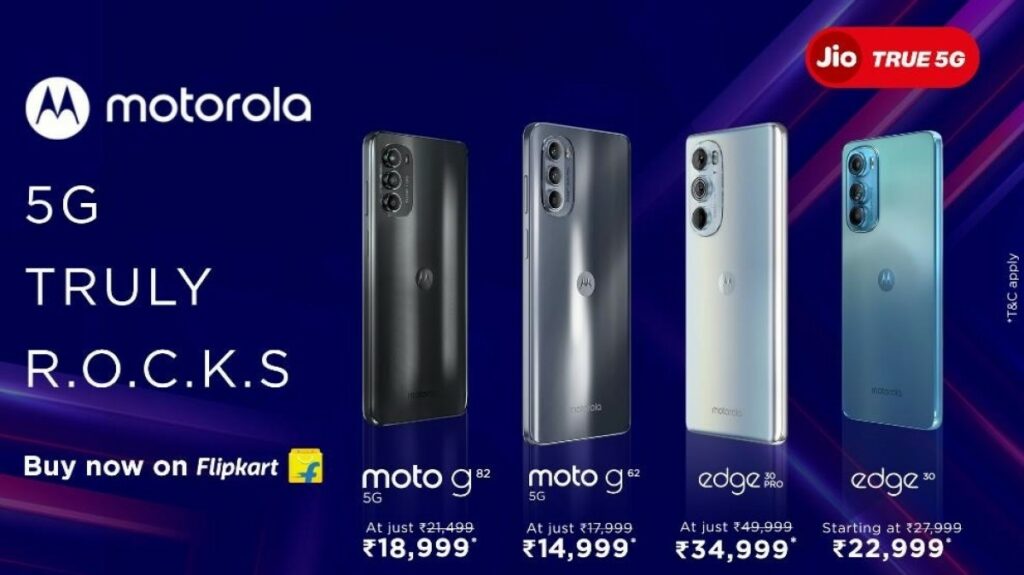
1-8 #Tired : Qualcomm has announced Snapdragon Satellite; realme has detailed its new 240W charging standard; Motorola has announced that it has enabled Jio’s 5G on its 10 eligible devices sold in India; etc.

Google has filed a legal challenge in India’s Supreme Court to block a ruling by the country’s antitrust watchdog that will force the U.S. company to change how it markets its Android platform. The Competition Commission of India (CCI) in Oct 2022 fined the Alphabet unit USD161M for exploiting its dominant position in the market for Android, which powers 97% of smartphones in India and is a key growth region for Google.(Engadget, Reuters)
France’s data protection authority CNIL has fined Apple EUR8M for privacy violations. The regulator found that Apple did not “obtain the consent of French iPhone users (iOS 14.6 version) before depositing and/or writing identifiers used for advertising purposes on their terminals”. The case stems from a Mar 2021 complaint lodged by startup lobby France Digitale, which argued Apple did not respect data protection rules. (CN Beta, TechCrunch, Politico, CNIL, Reuters)
Apple is expected to enlist a Chinese manufacturer to assemble its premium iPhone models, breaking Foxconn’s hold on production after the Taiwanese company was hit by worker protests over Covid-19 curbs at its largest Chinese factory. Apple is set to sign its first big order with Luxshare Precision, a competitor to both Foxconn and Taiwan’s Pegatron. Luxshare has already been producing small amounts of the iPhone 14 Pro Max at its plant in Kunshan, north-west of Shanghai, to compensate for lost production at Foxconn’s Chinese factory in Zhengzhou since Nov 2022. Goertek and Wingtech, assemblers of AirPods and MacBooks, have benefited, while Foxconn has attempted to reduce its reliance on China by establishing plants in India, Vietnam and the US. (CN Beta, Yahoo, UDN, CNYES, China Times, Financial Times, Reuters)
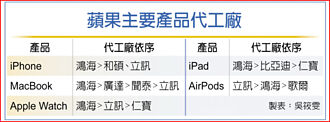

TF Securities analyst Ming-Chi Kuo has revised his prediction for the official debut of the highly anticipated Apple augmented reality device, suggesting that the company will now announce it in spring 2023. Apple still faces delays with its mixed-reality headset. He cites issues “with mechanical component drop testing and the availability of software development tools”. While he believes that the device may be announced in 1H23, he expects that it will not begin shipping until the end of the 2Q23 or 3Q23. (Apple Insider, Twitter, GSM Arena)
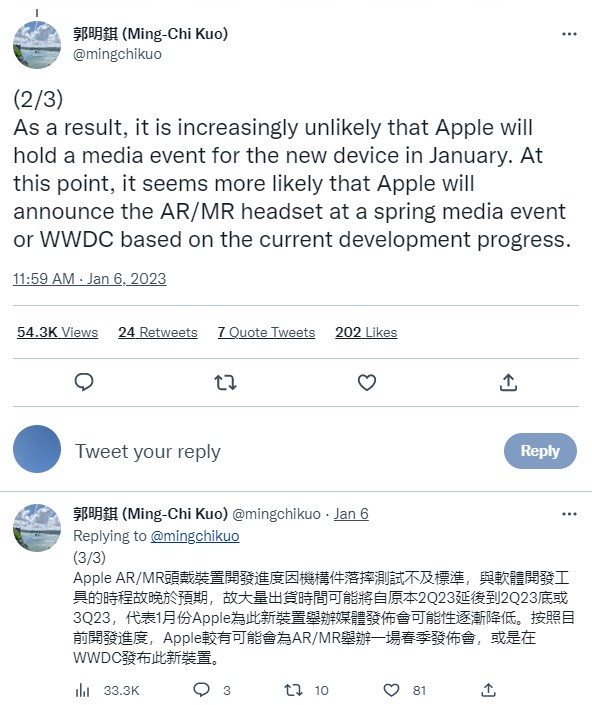

Volvo and sister company Polestar will be partners in launching Google’s new HD Maps service – an integrated solution designed specifically for automotive applications that pulls realtime data to improve vehicle navigation. The new tech will launch in Volvo’s all-electric EX90 and the Polestar 3. HD Maps will integrate sensor data with real-time traffic information to better enhance route planning and will talk to the onboard Pilot Assist semi-autonomous suite to provide highly accurate information about the vehicle and its surroundings. Volvo says the new suite will be available on models equipped with its Pilot Assist system.(CN Beta, TechCrunch, Autoblog)
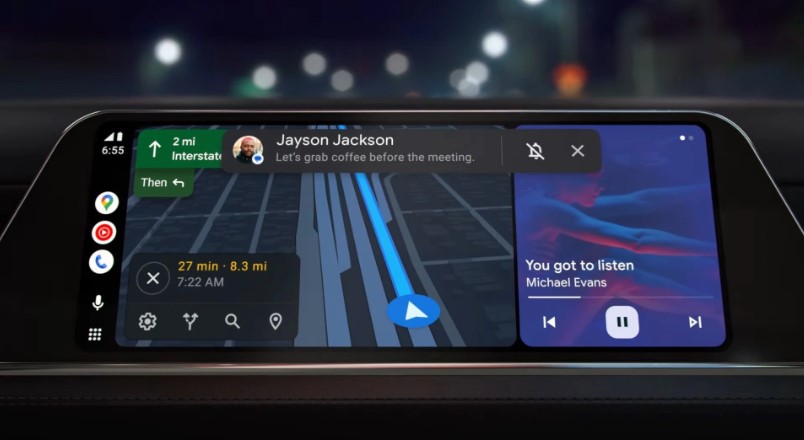
Sony and Honda’s joint mobility venture has unveiled a new EV prototype called Afeela. Over 40 sensors, including cameras, radar, ultrasonic, and lidar, will be embedded all over the exterior of vehicle, enhancing its ability to detect objects and drive autonomously. According to Sony Honda Mobility CEO Yasuhide Mizuno, Afeela will attempt to embody three main themes, including autonomy, augmentation, and affinity.(Engadget, New Atlas, Japan Times, The Verge)
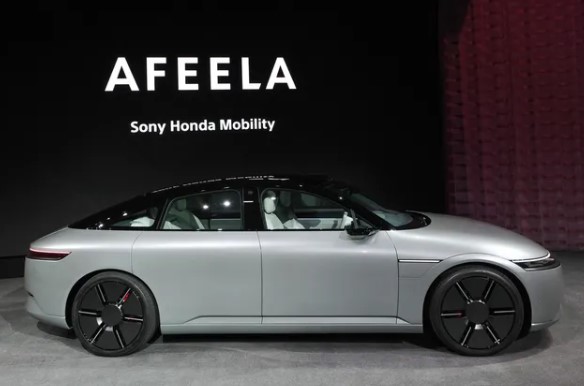
Full-year 2022 U.S. auto sales are forecast by Cox Automotive to finish near 13.9M units, a decrease of nearly 8.0% from 15.1M in 2021 and down 20% from the market peak in 2016. The annual vehicle sales pace in Dec 2022 is expected to finish near 13.2M, down 0.9M from Nov’s 14.1M pace but an increase from 12.7M level in 2021. General Motors is forecast to reclaim its title from Toyota Motor as the top seller in the U.S. market. Tesla grabs more share in 2022, Honda, Nissan fall. (CN Beta, Market Screener, Cox Automotive, CBT News)
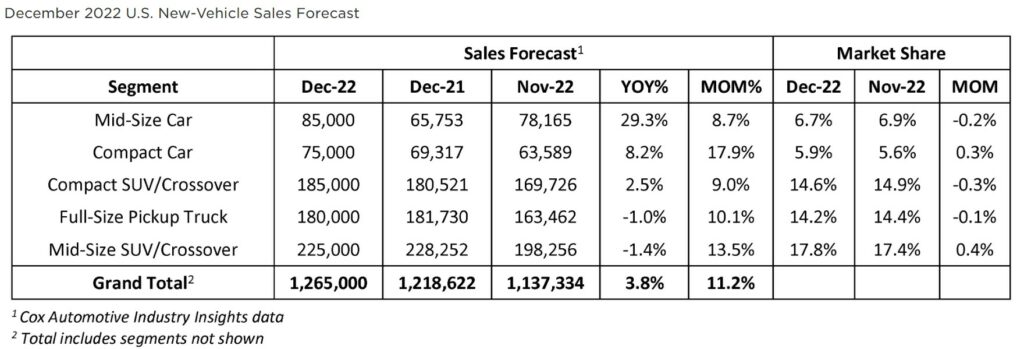
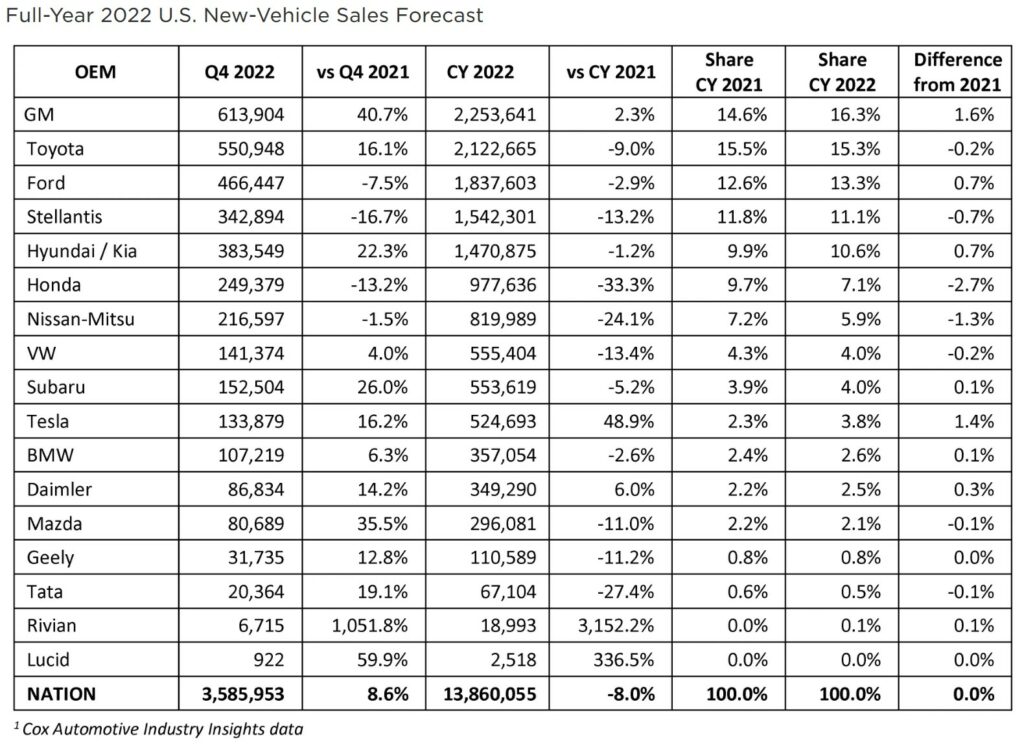
BMW has revealed a prototype for the i Vision Dee concept car. The four-door sedan came out onstage in a crisp white, but later morphed into a variety of colors and patterns to show off Dee’s E Ink technology, which will allow car owners to configure the car’s exterior with 32 different colors. Dee, while a concept car, is emblematic of BMW’s next-generation platform, Neue Klasse, which the company said will launch in 2025, starting with a dynamic sedan and a sporty activity vehicle.(TechCrunch, CNN, Designboom, Pocket-Lint)
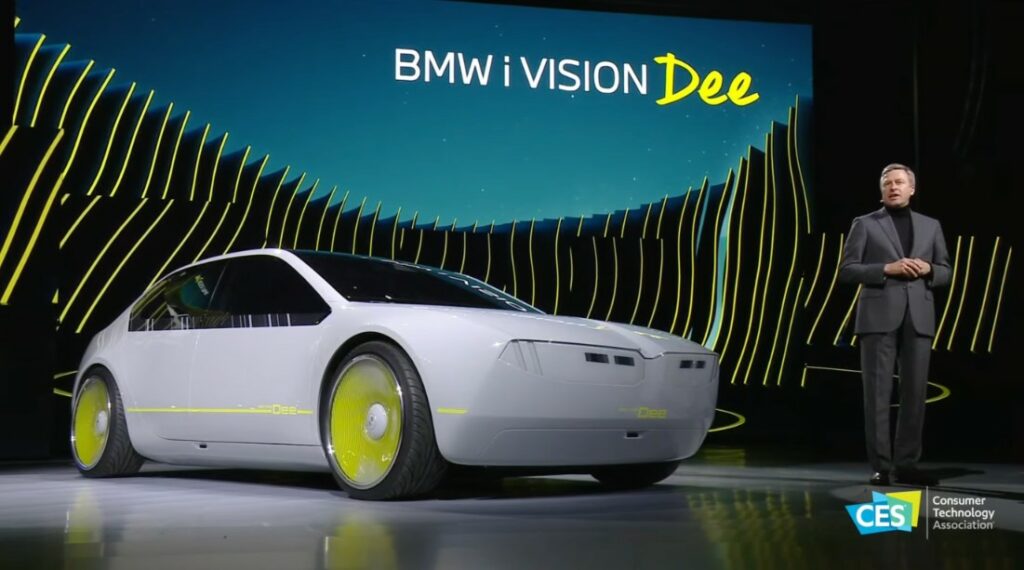

US listed crypto exchange Coinbase has reached a USD100M settlement with New York regulators for anti money laundering failures including a backlog of more than 100,000 unreviewed transactions and a reliance on social media profiles to verify customers’ identities. The New York State Department of Financial Services has said that Coinbase would pay a USD50M fine for weak compliance measures and would spend a further $50mn on a two-year programme to improve its systems. The DFS has said Coinbase’s systems for enforcing anti money laundering rules had been “immature and inadequate”, leaving the exchange “vulnerable to serious criminal conduct” including “examples of fraud, possible money laundering, suspected child sexual abuse material-related activity, and potential narcotics trafficking”. (CN Beta, CNBC, Financial Review, Financial Times)

Ant Group’s founder Jack Ma will give up control of the Chinese fintech giant in an overhaul that seeks to draw a line under a regulatory crackdown that was triggered soon after its mammoth stock market debut was scuppered 2 years ago. Ant’s USD37B IPO, which would have been the world’s largest, was cancelled at the last minute in Nov 2020, leading to a forced restructuring of the financial technology firm and speculation the Chinese billionaire would have to cede control. Ma previously possessed more than 50% of voting rights at Ant but the changes will mean that his share falls to 6.2%.(Engadget, WSJ, Fortune)
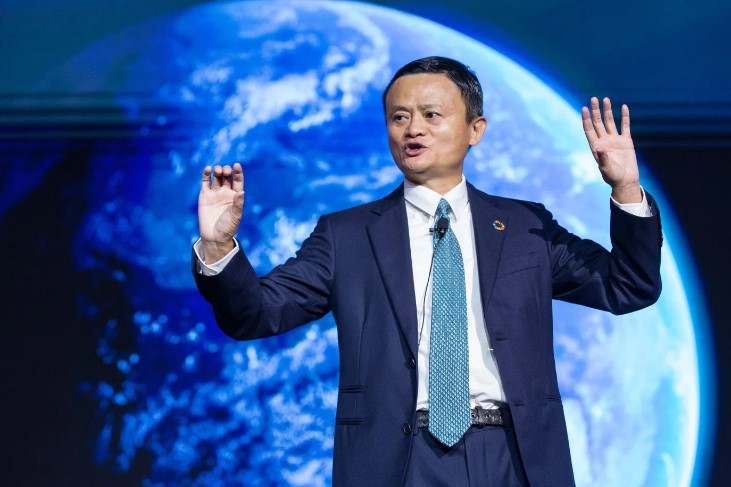
Clients pulled USD8.1B in deposits from Silvergate during a “crisis of confidence” late 2022, forcing the crypto-focused US bank to sell assets and underscoring how the implosion of FTX reached the regulated financial sector. The California-based group’s disclosure showing its deposits from digital asset customers shrank to USD3.8B on 31 Dec 2022 from USD11.9B at the end of Sept 2022 sent its shares plummeting almost 43% in New York trading. Silvergate, which is a Federal Reserve member bank and is listed on the New York Stock Exchange, has come under heavy pressure over the past year as crypto asset prices have tumbled and several big players have collapsed into bankruptcy. The bank’s share price had tumbled 88% in 2022. Silvergate has grown from a tiny community lender into a major crypto bank in recent years and was key in providing services to Sam Bankman-Fried’s now-collapsed crypto empire. (CN Beta, BBC News, Coindesk, SEC, CNBC, Financial Times)
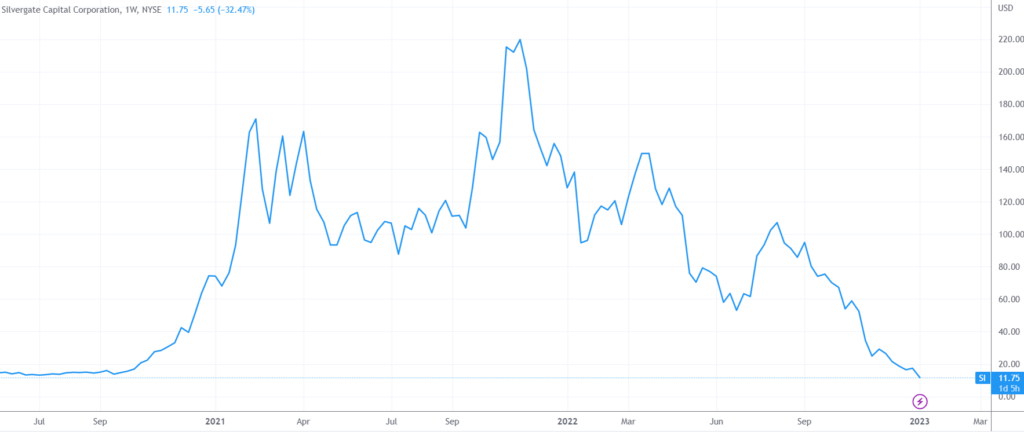
Mastercard is launching a web3-focused incubator to help artists connect with fans through a new medium. Mastercard partnered with Polygon, a scaling blockchain built on top of Ethereum, which has been making huge strides in the Web 2.0 ecosystem lately. In 2022, Polygon partnered with a number of other big brands like Starbucks for its Odyssey digital collectible rewards program and Disney for its accelerator program, while also having major clothing brands like Prada and Adidas launch NFT projects through its blockchain.(TechCrunch, Mastercard, NFTgators, Binance)


According to TF Securities analayst Ming-chi Kuo, Apple’s production and shipment plans for the 2024 iPhone SE 4 have been canceled rather than delayed. Due to concerns that the performance of the in-house baseband chip may not be up to par with Qualcomm’s, Apple initially planned to launch its baseband chip in 2024 and let the low-end iPhone SE 4 adopt it first, and decide whether to let the iPhone 16 use its baseband chip depending on the development status of iPhone SE 4. However, the cancelation of the iPhone SE 4 has significantly increased the chances of Qualcomm remaining the exclusive supplier of baseband chips for the 2H24 new iPhone 16 series, which is better than the market consensus that Qualcomm will start losing iPhone orders in 2024. Qualcomm is expected to continue to dominate the global high-end mobile phone RF market in 2023 and 2024 at least, leading to markedly higher profits than its competitors. The company’s strong product mix, which confers competitive advantages, is expected to mitigate the negative impacts of the economic recession and allow Qualcomm to return to solid growth ahead of its competitors once the economy recovers. (CN Beta, Twitter, Medium)
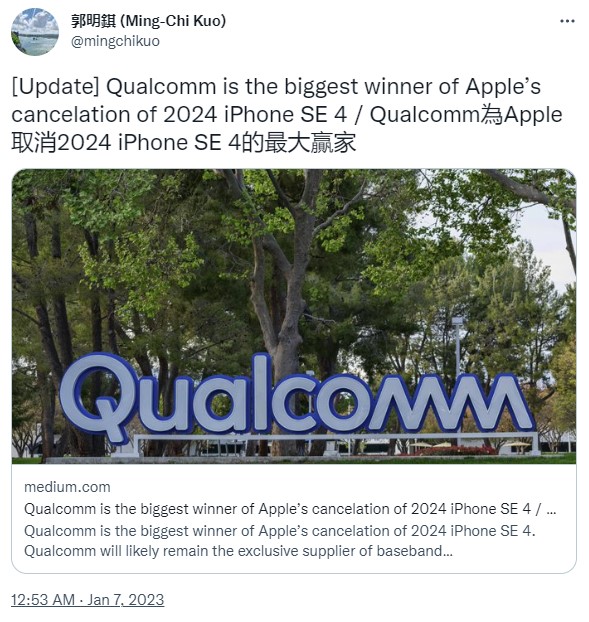
Qualcomm has announced Snapdragon Satellite — the world’s first satellite-based two-way capable messaging solution for premium smartphones. Qualcomm has partnered with Iridium to take advantage of its 66 low-orbit satellites spread across the globe. Snapdragon Satellite will provide global connectivity using mobile messaging from around the world1, starting with devices based on the flagship Snapdragon 8 Gen 2 Mobile Platform. The solution for smartphones utilizes Iridium’s weather-resilient L-band spectrum for uplink and downlink. Emergency messaging on Snapdragon Satellite is planned to be available on next-generation smartphones, launched in select regions starting in 2H23. Garmin will collaborate with Qualcomm “with support for emergency messaging”.(Android Authority, Qualcomm, GSM Arena, CN Beta)
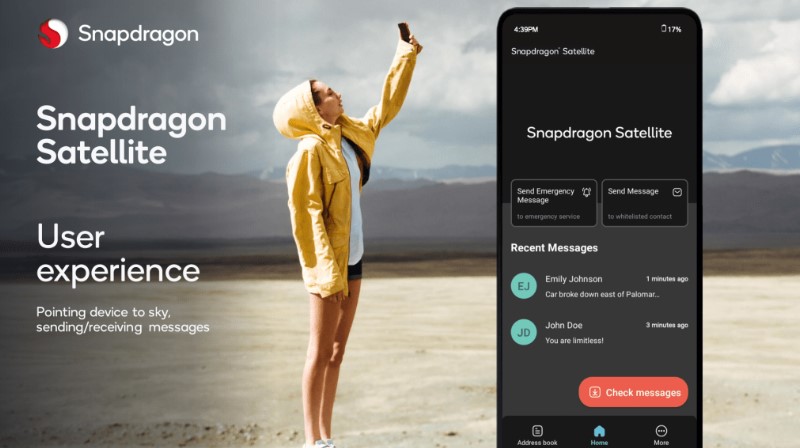
Qualcomm has announced the latest addition to the company’s growing Snapdragon Digital Chassis product portfolio with the introduction of the Snapdragon Ride Flex SoC. The Flex SoC is engineered to support mixed-criticality workloads across heterogenous compute resources, allowing for the digital cockpit, ADAS and AD functions to co-exist on a single SoC. Designed to meet the highest level of automotive safety, the Flex SoC enables a hardware architecture to support isolation, freedom from interference, and quality-of-service (QoS) for specific ADAS functions and comes equipped with a dedicated Automotive Safety Integrity Level D (ASIL-D) safety island. Furthermore, the Flex SoC pre-integrates a software platform that supports multi-operating system operating concurrently, hypervisor enablement with isolated virtual machines, and real-time operating system (OS) with an Automotive Open System Architecture (AUTOSAR) to meet the mixed criticality workload requirements for driver assistance safety systems, digital reconfigurable clusters, infotainment systems, driver monitoring systems (DMS), and park-assist systems. (CN Beta, Qualcomm, Automotive Live, Forbes)
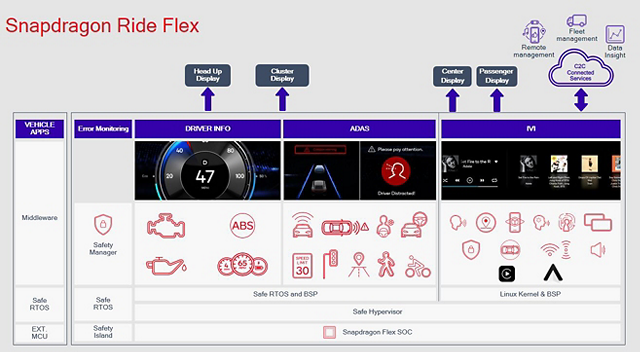
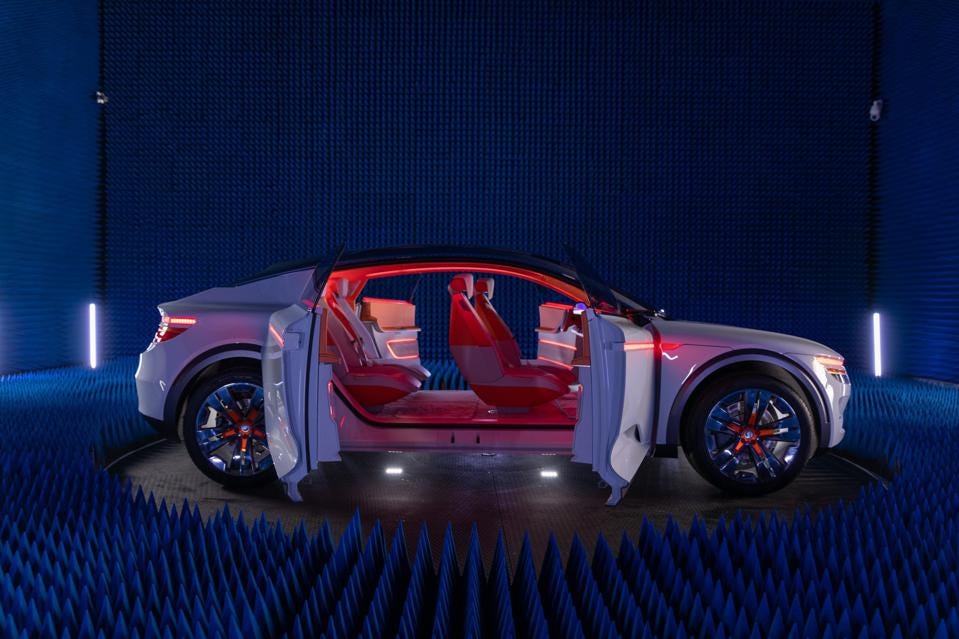
AMD has unveiled the Ryzen 7040 series, the industry’s first mobile x86 processor to feature a dedicated on-chip AI engine. The new Ryzen 7040 series is powered by the new Ryzen AI engine. The Ryzen AI engine is the first productized version of the new XDNA – a highly configurable accelerator adapted from AMD’s acquisition of Xilinx. The accelerator can be configured for different applications and the right power efficiency and will be deployed broadly across AMD’s product portfolio. The 7040 series for laptops is an ultrathin processor that uses 4nm process technology and houses more than 25B transistors – nearly twice as many as the Ryzen 6000 generation. The processors will enable more than 30 hours of battery life.(Android Authority, Notebook Check, ZDNet, AMD)
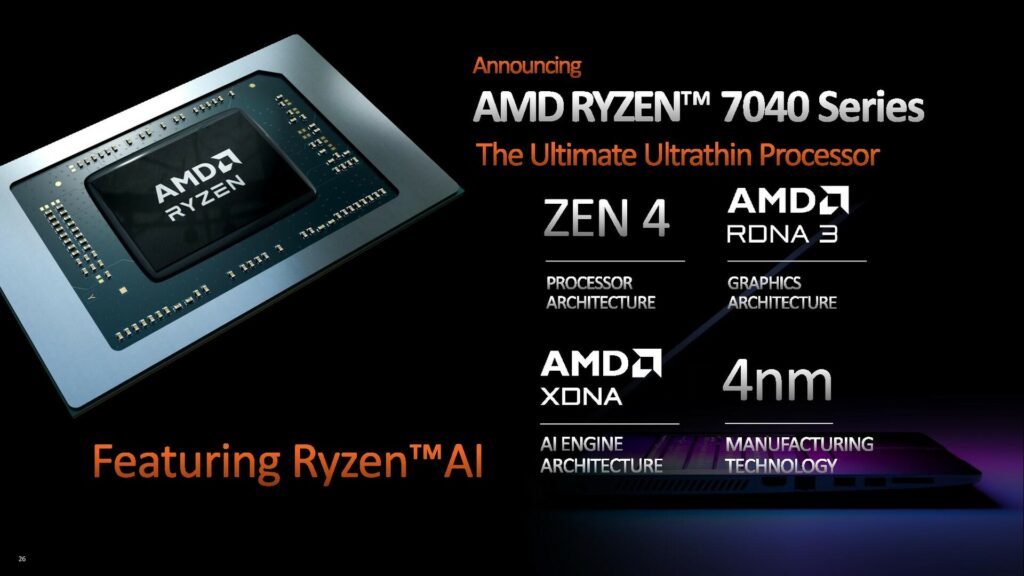
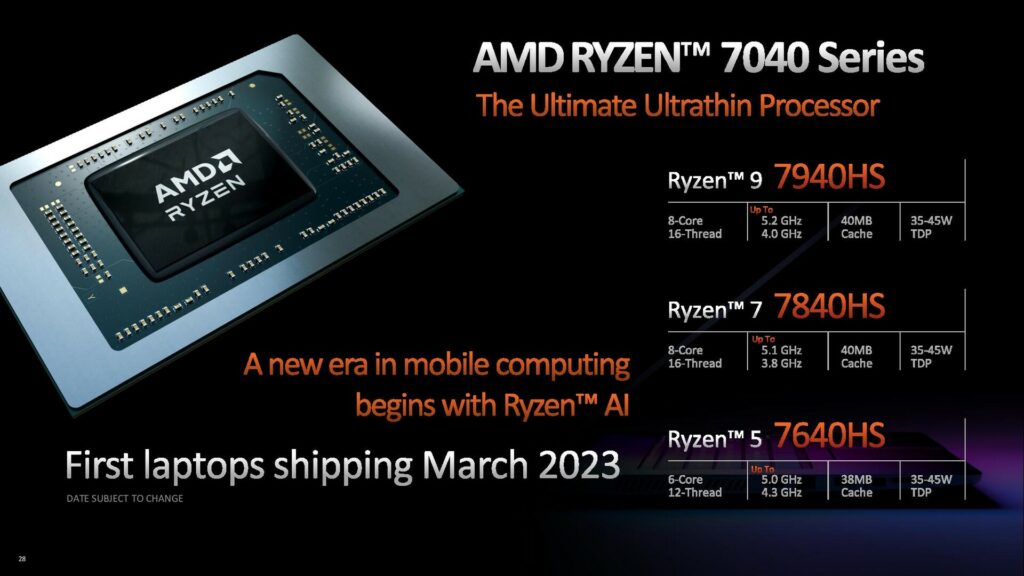
Google has officially announced that Android will support the RISC-V instruction set architecture. RISC-V is the Reduced Instruction Set Computer V architecture, which is an open, free-to-use standard without licensing or royalty fees. Google wants RISC-V on Android to be 64-bit only. The majority of Android apps ship in Java code, meaning that currently, almost no apps will support RISC-V on Android. However, Google says official emulator support is coming soon, while ART support should arrive sometime in 1Q23.(GSM Arena, Ars Technica, RISC)
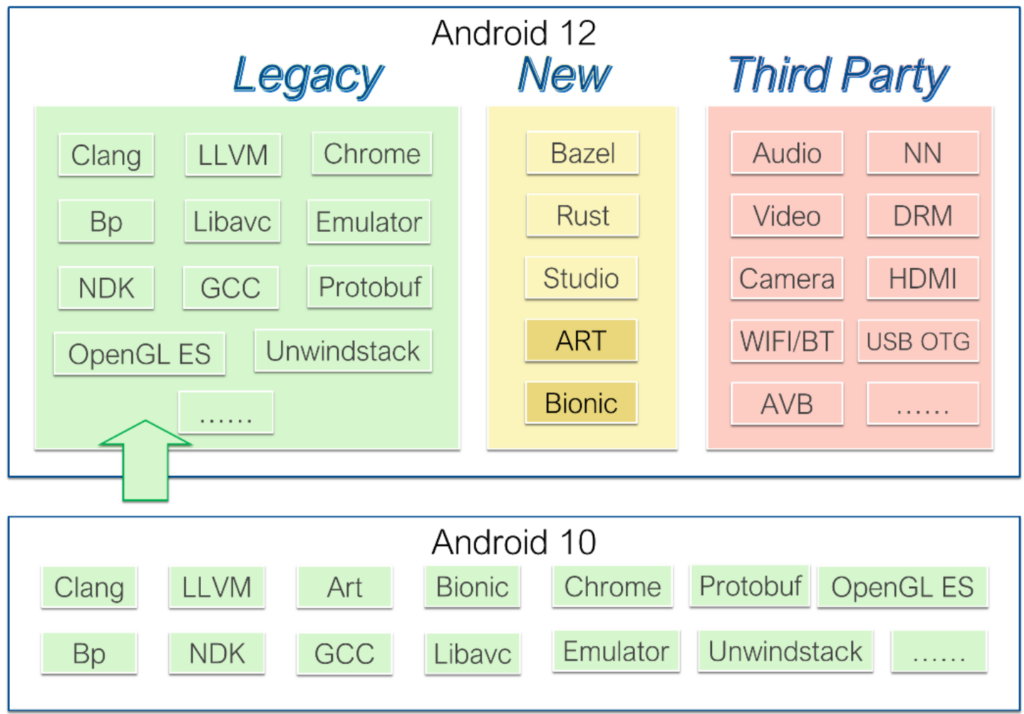

The Israeli-based augmented reality (AR) company Lumus will be expanding its 2D Maximus platform by unveiling its 2nd generation of Lumus’ Z-Lens waveguide architecture. This hardware advancement shrink the projector module by more than 50%, but it also enables the development of lightweight and high-resolution AR glasses with seamless Rx integration and outdoor brightness, paving the way for smaller, feature-packed AR glasses with Rx compatibility. With the Z-Lens architecture, Lumus is able to align the form and function of its products, which will allow the industry to reach a wider consumer base. The Z-Lens platform is designed to maintain the high image quality and performance of its predecessor, the Maximus, while reducing its size and weight. Its optical engine is also 50% smaller. (CN Beta, TechCrunch, VentureBeat, TechRadar, VRScout)
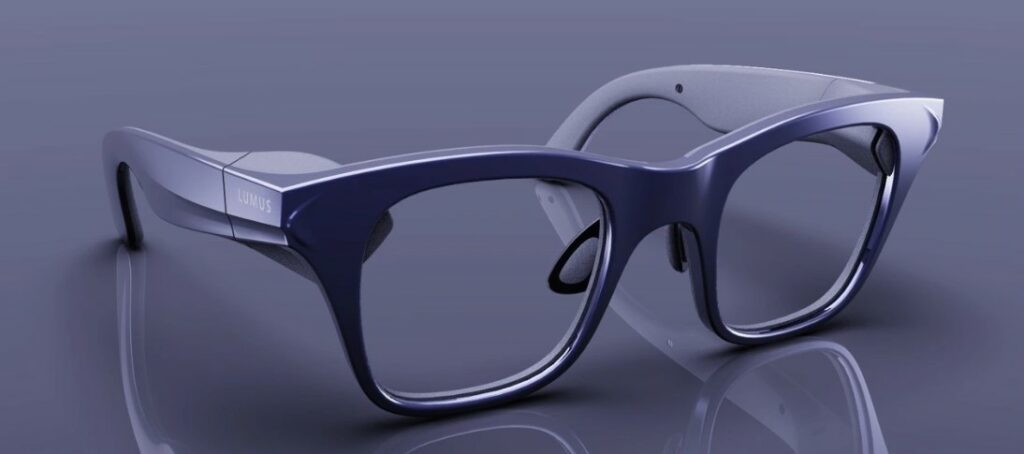
Samsung Display has announced that its smartphone OLED panel became the first in the industry to achieve the highest 2,000 nit luminance verification, the UDR (Ultra Dynamic Range) mark, granted by UL Solutions, a global safety science company. The company earned both UDR 1,500 and UDR 2,000 marks for its smartphone OLED display. As the UDR mark indicates the brightness excellence of a panel, Samsung Display’s OLED display, which acquire this mark, proves that it has been verified by a global leading verification company for its ultra-high-brightness capabilities, up to 1,500 or 2,000 nit, respectively.(GSM Arena, Samsung Display)
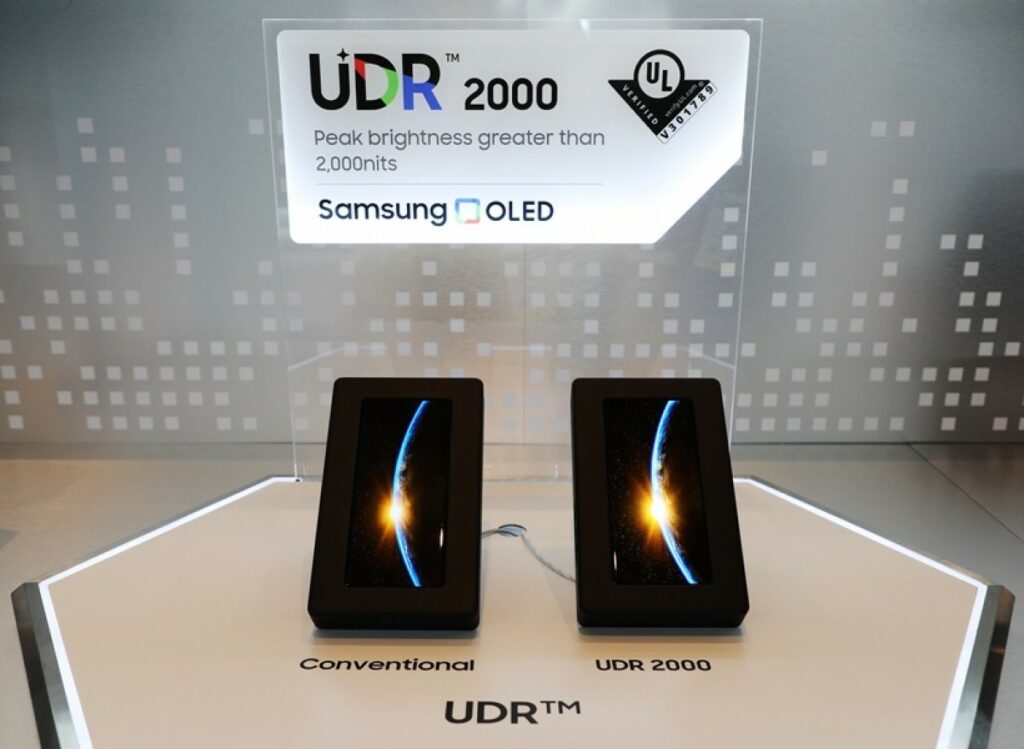
AR smart lens developer Mojo Vision has slashed 75% of its workforce across a variety of departments and functions amid the deepening funding crunch. Mojo Vision CEO Drew Perkins said that the company has now decided to pivot its business and focus its resources on Mojo’s Micro-LED technology. The company raised USD45M in its Series B-1 round in 2022. (CN Beta, TechCrunch, Axios, Business Insider, Mojo Vision)
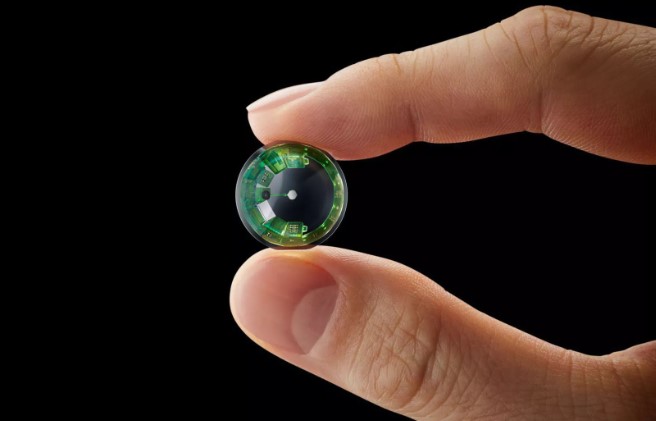
The Video Electronics Standards Association (VESA) has announced it will showcase product demonstrations of its latest video standards, including DisplayPort 2.1. Product demonstrations will highlight the unprecedented levels of performance for gaming, media playback and content creation enabled by VESA’s industry-leading video display standards. VESA will showcase PC gaming demos powered by AMD Radeon RX 7900 XTX graphics and the new AMD Radiance Display Engine supporting DisplayPort 2., alongside Samsung’s new 57-inch Odyssey Neo G9 8K2K 240Hz monitor running DisplayPort UHBR13.5. According to the official statement, the VESA DisplayPort 2.1 certified AMD Radeon RX 7900 series graphics card paired with Samsung’s Odyssey Neo G9 demonstrated a premium ultra-smooth, low-latency, high-refresh gaming experience with 8K2K DUHD 240Hz and UHBR13.5. (CN Beta, VESA, DisplaySpecifications, Sina)

realme has detailed its new 240W charging standard, which comes with a customized 12A charging cable for the 20V/12A throughput, delivered through three charging pumps. The USB-C adapter is has what the company calls double GaN components and is extremely small – 2.34W/cu.cm, which is about the same size as the 160W SuperDart adapter. realme details its 240W charging standard, promises to put it on its next flagship. The 240W charging architecture transforms the 20V/12A power to 10V/24A through 3 independent charging pumps, meaning the new phone will have three battery cells. The 12A cable will consist of four standard 21 AWG cables, which is a diameter of nearly 3mm just for the wire inside the plastic insulation.(CN Beta, Sina, GSM Arena, Trusted Reviews)
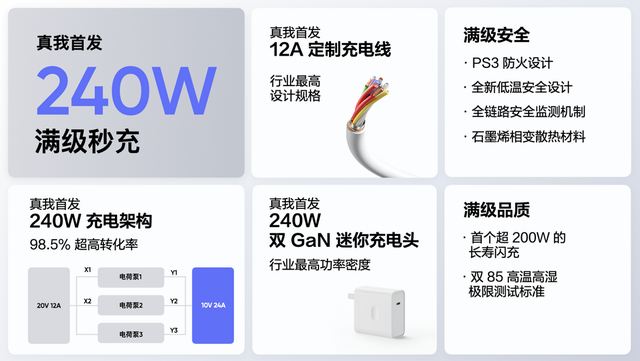

Google is rolling out the spatial audio feature with the rest of the Jan 2023 security updates for its flagship devices. In the list of changes arriving with the package, Google has included spatial audio support for all Pixel 6, Pixel 6 Pro, Pixel 7 and Pixel 7 Pro devices running Android 13. Spatial audio simulates an environment that makes users feel as if sounds are coming at them from different directions.(Engadget, 9to5Google, Google)
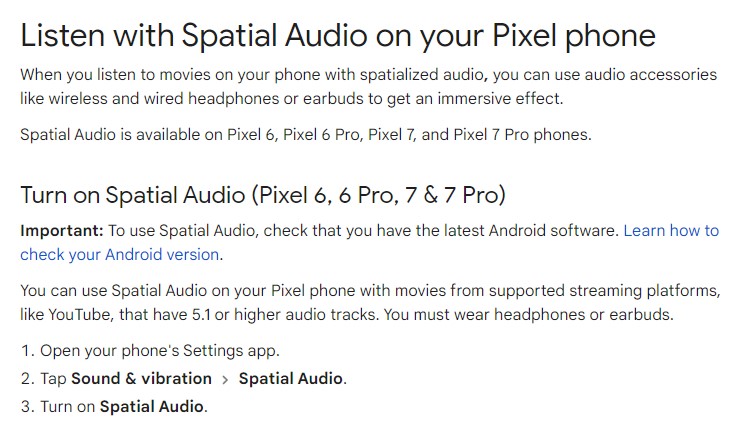
Lidar hardware company Luminar has announced it has acquired Civil Maps, a lidar data company based in San Francisco. The acquisition brings ultra-detailed and automatically updating 3D maps of various cities into Luminar’s fold as it plans to bring fully autonomous vehicles into reality. Luminar will integrate the Civil Maps assets, which include navigation data, into its Sentinel platform. Sentinel is the company’s full-stack software suite solution that’s currently in development for lidar-equipped cars, like the upcoming Volvo EX90. (The Verge, Business Wire, TechCrunch)


Skylo, a Non-Terrestrial Network (NTN) operator, focused on connecting anything, anywhere, has announced that it is partnering with Bullitt Group, the innovative British smartphone manufacturer, as Bullitt’s satellite connectivity partner for its two-way satellite messaging smartphone. Bullitt and Skylo’s engineering teams have worked closely together over the past 2 years in partnership with one of the world’s leading chipset supplier, MediaTek, to develop the world’s first 3GPP standards-based approach to satellite NTN or “direct-to-device” connectivity. Skylo provides the most robust, scalable network for direct-to-device connectivity while being incredibly efficient on the phone’s power consumption. (Android Authority, The Register, Business Wire, Pocket-Lint)
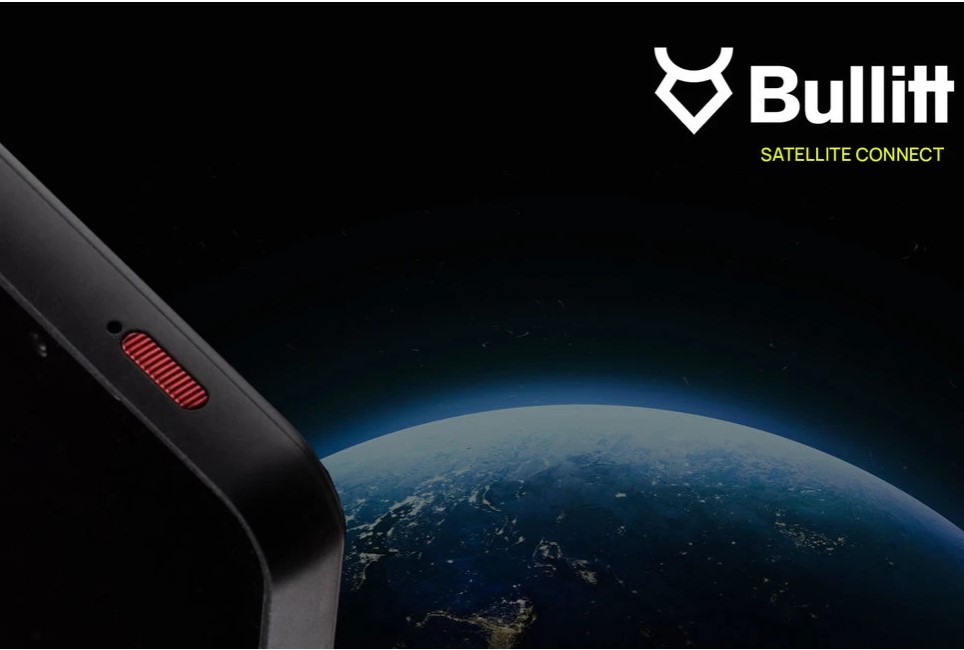
Motorola has announced that it has enabled Jio’s 5G on its 10 eligible devices sold in India. Motorola 5G users will be able to use Jio’s 5G stand-alone network that is independent of LTE; they will have “the largest and best mix of 5G spectrum across 700MHz, 3,500MHz and 26GHz bands” and will have flawless connectivity through technologies like 3CA (3 Carrier Aggregation), and 4X4 MIMO.(GSM Arena, India Today, Live Mint, 91Mobiles)
